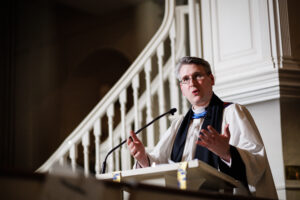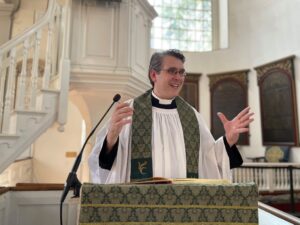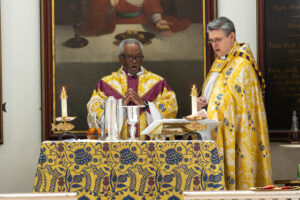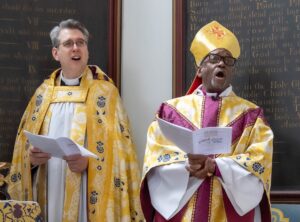Rev. Dr. Matthew Cadwell ’13 completed a PhD at the Trinity College Faculty of Divinity and now leads the famous and historical Old North Church in Boston. Fellow alumni Rev. Matthew Kieswetter and Dr. David Danner asked him five questions about his journey, his work and more.
1. You pastor one of America’s most historic and well-known churches. It is known for its part in the American Revolution, and yet today the church also appears to be conscious of its connection to England and the Royal Family. Add to all of this America’s political polarisation, and that is a lot of ‘bridge-building’ that must be woven into the ethos of the congregation. How do you manage in the midst of this?
My PhD thesis was focused on Anglican comprehensiveness (i.e., the ability to hold diverse beliefs and practices). We embrace that comprehensiveness at Old North, established in 1723 as the second Church of England congregation in overwhelmingly Congregationalist (Puritan) Boston. At the first service the sermon inspiration was Isaiah 56:7: “My house shall be called a house of prayer for all people.” For over 300 years Old North has held fast to that inspiration.
In 1975, Old North celebrated the 200th anniversary of the lantern signal with a visit by President Gerald Ford, who addressed the nation from the pulpit. The next year, in July 1976, Queen Elizabeth attended Sunday worship. In a speech following she said: “At Old North Church last year, your President lit a third lantern dedicated to America’s third century of freedom and to renew faith in the American ideals. May its light never be dimmed.” Since then, we have been a spiritual gathering place for British and Commonwealth communities in Boston while, of course, celebrating our role in American independence.
 And, we wrestle with history harder to reconcile with our deepest understandings of faith and freedom. Slavery was a real part of the church’s early life, as it was throughout colonial North America. The first two rectors held people in bondage. Enslaved people attended services and were baptized, married, and buried by the church. An early parishioner was a slave ship captain. I recently discovered a beautiful copy of the Works of Richard Hooker, of very special interest to me, published in 1666 and gifted to the church in 1727. It was donated by a benefactor who operated a sugar plantation in Antigua. Even this treasure is marked by a complicated history.
And, we wrestle with history harder to reconcile with our deepest understandings of faith and freedom. Slavery was a real part of the church’s early life, as it was throughout colonial North America. The first two rectors held people in bondage. Enslaved people attended services and were baptized, married, and buried by the church. An early parishioner was a slave ship captain. I recently discovered a beautiful copy of the Works of Richard Hooker, of very special interest to me, published in 1666 and gifted to the church in 1727. It was donated by a benefactor who operated a sugar plantation in Antigua. Even this treasure is marked by a complicated history.
So, we hold the glorious and not so glorious, division, contradiction, and reconciliation, in the past and today, as we tell our story. I constantly return to the dual call to be a house of prayer for all people and symbol of freedom, acknowledging with humility and hope that our understanding of what these ideals mean is always partial and ever growing.
2. You balance being a prime tourist attraction and historic site while also being a contemporary Episcopal congregation. How do you navigate that creative tension?
One of my predecessors referred to Old North as a church for the nation. We are, in fact, a mission church of the Diocese of Massachusetts. On any Sunday at least half of the congregation is comprised of visitors, For many, Old North is the first experience of Episcopal or Anglican worship. A teenager recently told me it was his first ever experience in a church. It is an incredible opportunity and responsibility, trusting that we, and especially God, are planting seeds that will grow and flourish elsewhere. This is the essence of being a mission church and house of prayer for all people. Yet, a persistent challenge is the fact that many do not realize we are still an active church. And as an historic site we are not free to change the space in ways others can. I think the box pews are isolating; but they are central to the experience and semi-historical. Visitors like the feeling of stepping back hundreds of years. We balance all of those realities.
 Two decades ago the Old North operation was divided into two interrelated but distinct entities: the church congregation which I serve as vicar (the bishop is ex officio rector); and what is now named Old North Illuminated, created by the congregation and diocese to oversee tourism, educational programming, and building preservation. Working together we have developed plans for accessible seating and an exciting project to restore 18th century cherubs painted in the arches above the galleries. Collaboration is not always easy, with sometimes contradictory interests (a museum in an active church; a church in a museum), but usually the result is rewarding.
Two decades ago the Old North operation was divided into two interrelated but distinct entities: the church congregation which I serve as vicar (the bishop is ex officio rector); and what is now named Old North Illuminated, created by the congregation and diocese to oversee tourism, educational programming, and building preservation. Working together we have developed plans for accessible seating and an exciting project to restore 18th century cherubs painted in the arches above the galleries. Collaboration is not always easy, with sometimes contradictory interests (a museum in an active church; a church in a museum), but usually the result is rewarding.
3. You attended an American college for your undergrad and Episcopal Divinity School for your M. Div. Describe your journey from New England to Toronto, and what academic and church life was like while studying at TST. How has Trinity contributed to your formation?
As an undergrad I had been interested in doctoral study in theology and tailored my M. Div. to facilitate dual goals of ordained ministry and further graduate work. However, having gone to seminary directly from undergrad, by the end of my M. Div. I felt that I needed a break from school. So, I took a few years to work and further prepare for ordination.
Three years on, I considered doctoral programs again. I was attracted by Trinity’s liberal catholic ethos, my hero being F. D. Maurice. David Neelands taught a course in Maurice, as well as Hooker and Anglican theology — unique among North American programs. Two of my best friends at EDS were Canadian; one had just taken a position in Toronto. When I received junior fellowships to help fund my program the stars seemed to align, stopping over Trinity College.
Upon arrival in 2003 I plunged in headfirst, living in residence with a large divinity contingent. My first term I was TA for Anglican History & Theology, a Trinity/Wycliffe course, giving me deeper insight into the breadth of thought within Anglicanism. The majority of my courses were at Trinity, with Dean Neelands, Marsha Hewitt, and Joanne McWilliam, but I also took TST courses in feminist theology, soteriology, a course on Bonhoeffer, and a directed reading course in liturgical theology with John Gibaut at St. Paul University in Ottawa. Eventually, I taught my own course in 20th century Anglican Theology, which continued online for several years.
Once ordained, after my first year of studies, I served several parishes as assistant and associate priest — St. Anne’s (tragically burned this summer); St Hilda’s; Trinity, Aurora; and Christ Church Deer Park, with supply work in several more. I appreciated the multicultural character of these parishes and carry with me learnings from each, and the rectors I served under.
I was especially blessed with a dedicated supervisor in David Neelands. And, I appreciated knowing scholars in the Trinity community from other fields — history, international relations, music, political science. One year I regularly attended Saturday sabbath services at different synagogues with a retired U of T history professor who included me in Passover celebrations with his family. It was a full and rich time which I cherish.
4. What is worship like at Old North? Are there any distinctive or unusual customs, like historical liturgies, that have been retained or revived because of its unique history and ministry?
 A typical Sunday Eucharist would be familiar to most Episcopalians or Canadian Anglicans, following a formal contemporary format — Rite II in the US Prayer Book or BAS in Canada. I do often import prayers from across Anglican and Lutheran traditions. On occasion we offer traditional language Choral Matins. Our music director, trained in Vienna, leads a choir comprised of paid and volunteer singers. A tradition since World War I is singing a verse of “My Country, ‘Tis of Thee” at the offertory: “Our fathers God to thee, author of liberty, to thee we sing: long may our land be bright, with freedom’s holy light, protect us by thy might, great God our King.” The tune will be familiar to Canadians, among others, as “God Save the King.”
A typical Sunday Eucharist would be familiar to most Episcopalians or Canadian Anglicans, following a formal contemporary format — Rite II in the US Prayer Book or BAS in Canada. I do often import prayers from across Anglican and Lutheran traditions. On occasion we offer traditional language Choral Matins. Our music director, trained in Vienna, leads a choir comprised of paid and volunteer singers. A tradition since World War I is singing a verse of “My Country, ‘Tis of Thee” at the offertory: “Our fathers God to thee, author of liberty, to thee we sing: long may our land be bright, with freedom’s holy light, protect us by thy might, great God our King.” The tune will be familiar to Canadians, among others, as “God Save the King.”
We do sing “God Save the King” on occasion, too: principally on Remembrance Sunday, which includes bagpipes, along with the recitation of “In Flanders Fields,” readings by the UK and Canadian Consuls General, and a wreath-laying with military representation from the British Embassy in Washington. A memorial on church grounds, principally in honor of American service members killed in Afghanistan and Iraq, also includes a bronze poppy wreath plaque honoring British and Commonwealth service members. In April we commemorated the centenary of the Royal Canadian Air Force, joined by Canada’s Consul General in Boston. Several of us at Old North — me included — have relatives who served in the RCAF during World War II. In October we will add an additional plaque memorializing Americans who served in the Canadian forces.
At my installation, the bishop noted that Old North has never quite lost her English accent, and that’s certainly true. In 2022 we celebrated the Platinum Jubilee with a grand service and garden party. Months later, we hosted the British Consulate’s condolence book and offered a memorial service on behalf of the diocese and the British and Commonwealth communities after Queen Elizabeth’s death. In 2023 we held a service in honor of King Charles’s coronation. I am grateful to my time in Toronto preparing me somewhat for this unexpected context in ministry.
While most visitors come because of the Revolutionary story, we hope they leave uplifted by reverent worship, drawn from the richness of our Anglican/Episcopal heritage, which speaks not only to a storied past but the realities of life today.
5. How do you hold together your pastoral and academic vocations? In this time of change and challenge in the world of theological education, do you have any particular experiences, views, or values that you would commend to an Anglican theological school like Trinity?
With so much history, Old North provides ample opportunity for interesting research. A personal project has involved William Walter, our fifth rector — a loyalist priest in another Boston parish who fled to Nova Scotia during the Revolution. His brother-in-law had been Old North’s loyalist rector, who also fled to Canada. Walter was friendly with John and Abigail Adams and was begged by Old North’s leadership to return to Boston to take up the rector post, proving that after the war all sides wanted to heal and look to the future. It is a fascinating, untold story, reflecting the complexities of their time and exemplifying the best of Anglican comprehensiveness.
Since 2018 I have taught systematic theology in our diocese’s deacon formation program. This fall I added teaching Anglican/Episcopal history and polity online in Bexley Seabury Seminary’s “Pathways for Baptismal Living” program. Some participants are enrolled in other seminary programs. Others are preparing for the diaconate. Still others are looking to deepen their understanding of the church.
Recent developments in theological education have been dramatic, altering the landscape many of us have known and assumed were nearly eternal. Venerable schools have closed, sold campuses, or reimagined themselves. Online education has become far more normative. Many schools have guaranteed debt-free education. In the midst of all that change, I believe Trinity still offers appealing opportunities, perhaps even more so today as several peer institutions have shifted focus: Anglican formation in the liberal catholic tradition in a diverse university and urban context; a strong ecumenical consortium which supports learning across Christian traditions; incomparable facilities and library access; hybrid options for several programs. Given all these strengths, I wonder how the Faculty could promote itself more boldly, especially in the US, where seminaries that had similar distinctives have seen dramatic changes. Some options might include establishing a presence at General Convention, to tell Trinity’s story to a wider audience and being intentionally in touch with alumni in the Episcopal Church about possibilities for promotion within dioceses and among bishops, etc. There’s no question in my mind that future clergy, lay leaders, and academics could benefit from Trinity’s unique strengths.
BONUS QUESTION: Beyond ministry life you find stimulation and enrichment through your love of Sweden, and also, Star Wars. Say more about how you connect with these two ‘S’ passions.
Ha! I am a child of the 70s and 80s. Star Wars was my greatest passion. Allusions regularly find their way into sermons. I have a Star Wars lunch box that often accompanies me to work or meetings. I even used it at our recent bishop’s election! I thought we could use an extra dose of the Force. It was very popular.
Visiting Sweden and Scandinavia is always life-giving. I enjoy Scandinavian cooking, especially baking, and always keep a supply of cardamom and almond extract handy. I confess to spending a good deal on Swedish/Scandinavian home décor, too. Once, in seeing a photo of my home on Facebook, a friend commented that it looked like the Scandinavian gift shop in our college town exploded in there. It’s kind of true. I also speak Swedish. My last parish had a parishioner whose first language was Swedish; speaking it much better than English. We talked often. When he died I offered prayers in Swedish. I don’t have that now, but we do have visitors who are surprised when the vicar of a church in Boston launches into their language while shaking hands at the door. So, too, is everyone else wondering what strange thing they are unexpectedly hearing. That’s fun.
The following linked news story, aired nationally on public radio, covers some of Old North’s efforts at addressing slavery and racial reconciliation: https://www.wgbh.org/news/education-news/2022-11-30/old-north-church-a-beacon-of-freedom-grapples-with-its-own-ties-to-slavery



